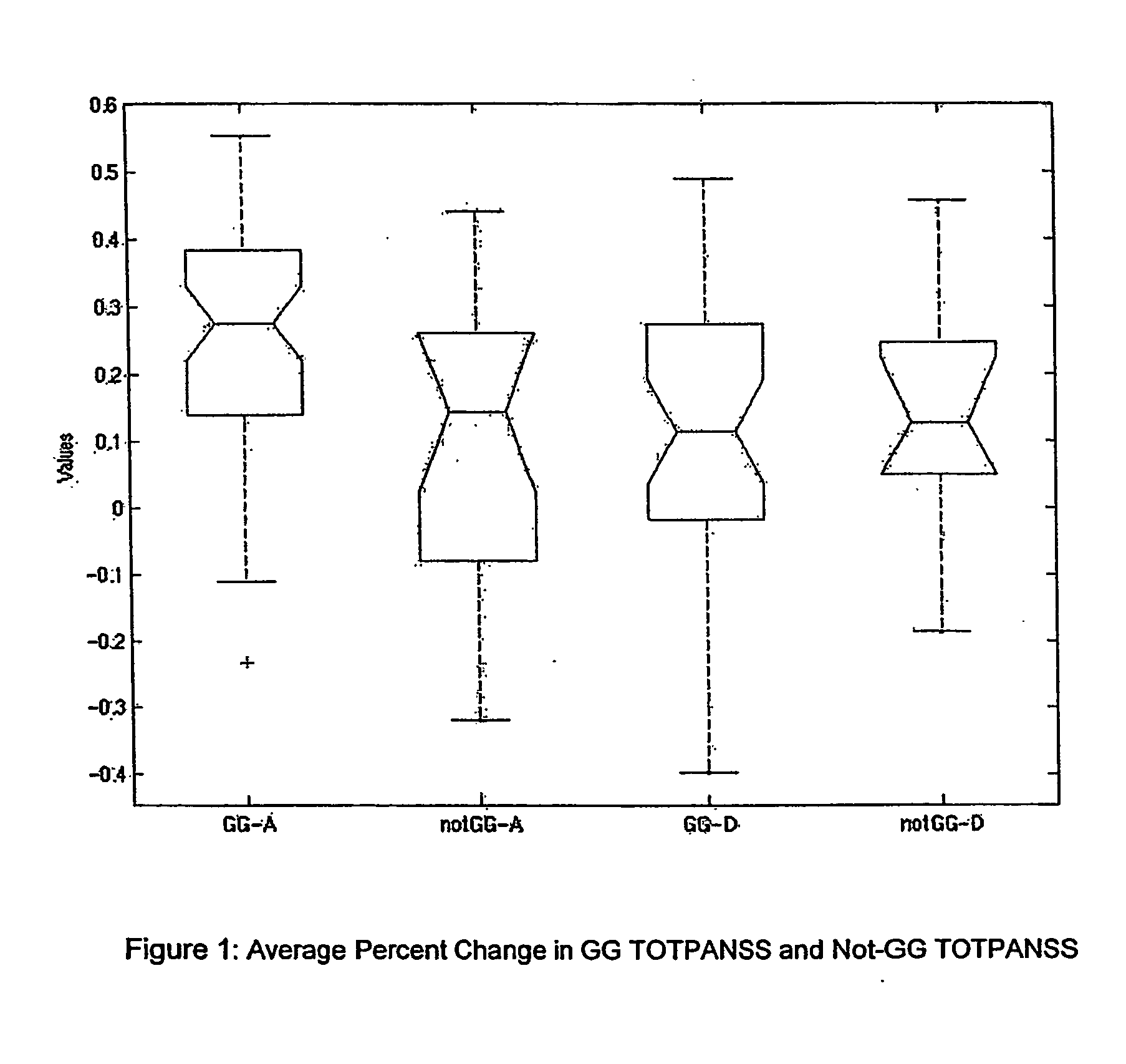Methods of treating psychosis and schizophrenia based on polymorphisms in the cntf gene
a polymorphism and gene technology, applied in the field of psychosis and schizophrenia treatment methods based on polymorphisms in the cntf gene, can solve the problems of no means, other than trial and error, to determine, time-consuming, unpleasant and even dangerous for patients, and achieves less resistance to, minimise side effects, and high dose
- Summary
- Abstract
- Description
- Claims
- Application Information
AI Technical Summary
Benefits of technology
Problems solved by technology
Method used
Image
Examples
example 1
Some aspects of the present invention can be demonstrated by an example showing the manner in which the correlation between the polymorphism in the CNTF gene and response to antipsychotic medication was first found.
In an effort to identify genetic factors that may associate with treatment response to lloperidone, the relationship between a polymorphism in the CNTF (ciliary neurotrophic factor) gene (located on 11q12.2, the polymorphism being 103 G>A in GenBank sequence X55890 (Version 1), see PubMed: 9285965) and the clinical response to the antipsychotic lloperidone in a clinical trial was investigated. This trial was a randomized, double-blind, placebo- and risperidone-controlled, multicenter study to evaluate the efficacy and safety of two non-overlapping dose ranges of lloperidone (12 or 16 mg / d and 20 or 24 mg / d and risperidone (6 or 8 mg / d) compared with placebo, given twice-daily (b.i.d) for 42 days to schizophrenic patients followed by a long-term treatment phase with llo...
example 2
A 30 year old woman with new onset of a psychotic disorder is seen by a physician. After diagnosing a psychotic disorder that could be benefited by antipsychotic agents, her physician counsels the patient about the possibility of testing her for the presence of the polymorphism in the CNTF gene and explains what this result would mean with regard to the use of medication, including lloperidone.
With the patients consent, the physician performs a test to determine the patient's genotype and determines that the patient has the GG form or the M form of the CNTF gene at position 103. The physician discusses with the patient the short- and long-term consequences of antipsychotic medication treatment. The physician also discusses the other available treatment modalities and medications.
On the basis of these results, the physician recommends and the patient agrees to a trial of a medication such as lloperidone to help control the symptoms of the psychotic disorder with the expectation ...
example 3
A 52 year old man, with a psychotic disorder is seen by his physician with complaints of typical antipsychotic side effects such as akathesia and dyskinesias. The patient is being treated with lloperidone and his psychotic symptoms are in good control but he is experiencing numerous side effects from the medication. The physician recommends genotyping and counsels the patient regarding the treatment options that the genotyping results would allow. The patient is tested and determined to have one of the genotypes, i.e. GG or AA, associated with the most favorable response to lloperidone. On the basis of this result and the expected high sensitivity to lloperidone the physician is able to recommend a treatment regimen with a substantially lower dose of lloperidone with reduced likelihood of side effects. The physician is able to reduce the patients lloperidone dose and reduce side effects and improve patient compliance without risking the worsening of the patients psychotic disorder ...
PUM
| Property | Measurement | Unit |
|---|---|---|
| Magnetic field | aaaaa | aaaaa |
Abstract
Description
Claims
Application Information
 Login to View More
Login to View More - R&D
- Intellectual Property
- Life Sciences
- Materials
- Tech Scout
- Unparalleled Data Quality
- Higher Quality Content
- 60% Fewer Hallucinations
Browse by: Latest US Patents, China's latest patents, Technical Efficacy Thesaurus, Application Domain, Technology Topic, Popular Technical Reports.
© 2025 PatSnap. All rights reserved.Legal|Privacy policy|Modern Slavery Act Transparency Statement|Sitemap|About US| Contact US: help@patsnap.com

